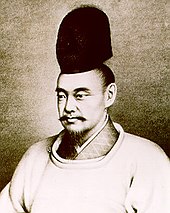Tokugawa Nariaki
Tokugawa Nariaki ( Japanese 徳 川 斉 昭 ; * April 4, 1800 ; † September 29, 1860 ) was the 9th daimyo of the Mito fief (now Ibaraki Prefecture ). He was the head of one of the "Three Families" (御 三家, Gosanke) who could provide the Shogun if the main line was without an inheritance.
Live and act
Tokugawa Nariaki took over the Mito domain as successor in 1829. He carried out a number of reforms and gave important posts to experienced staff such as Aizawa Seishisai (会 沢 正 志 斎; 1782–1863) and Fujita Tōko (藤田 東湖; 1806–1855). In 1841 he set up the Kōdōkan School , in which Western sciences were taught and the Sonnō jōi efforts, i.e. the return of supreme power to the emperor , were promoted. Nariaki's activities angered the Tokugawa shogunate : he was deposed as a daimyo in 1844 and sentenced to house arrest. He then left the management of the domain to his son Yoshiatsu until the ban was lifted in 1849.
During the excitement associated with the appearance of American Admiral Perry's ships in 1853, Nariaki was asked by the head of administration of the shogunate, Abe Masahiro , to serve as an adviser to the central government on coastal defense. When it came to the successor to the late Shogun Tokugawa x, who died childless, Nariaki was the main representative of the Hitotsubashi faction. This group supported Nariaki's 7th son, Yoshinobu, who was adopted by the Hitotsubashi family, one of the Tokugawa Gosankyō. Nariaki got into a conflict with the Chancellor Ii Naosuke , who found Tokugawa Iemochi from the house of the Wakayama branch of the Tokugawa family to be more suitable and employed him in 1858 as the 14th Shogun. Another conflict sparked the Harris Treaty in the same year: Nariaki criticized that the contract had come about without an imperial signature. The shogunate responded by convicting Nariaki, who had to spend the rest of his life in house arrest.
Posthumously Nariaki was given the name "Rekkō" (烈 公) - about "Strong Prince". He is venerated in the Tokiwa shrine in Mito as "Oshi-take-ō-kuni-no-mitate-no-mikoto".
Nariaki's son Yoshinobu became a shogun after the early death of Iemochi in 1866, but had to abdicate after two years as part of the Meiji restoration .
Remarks
- ↑ The Gosankyō (御 三 卿) were three branch families of the Tokugawa with certain privileges. So they resided on the grounds of the Shogun Palace.
literature
- S. Noma (Ed.): Tokugawa Nariaki . In: Japan. An Illustrated Encyclopedia. Kodansha, 1993, ISBN 4-06-205938-X , p. 1570.
| personal data | |
|---|---|
| SURNAME | Tokugawa Nariaki |
| ALTERNATIVE NAMES | 徳 川 斉 昭 (Japanese) |
| BRIEF DESCRIPTION | Daimyo from Mito |
| DATE OF BIRTH | April 4, 1800 |
| DATE OF DEATH | September 29, 1860 |

